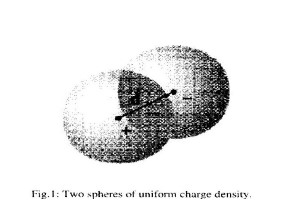PHY 102: Introduction to Physics-2
Tutorial-4
(Gauss’s Law,Electric Potential)
- Electric field: The spheres, each of radius $R$ and carrying uniform charge densities $+\rho$ and $-\rho$, respectively, are placed so that they partially overlap (Fig.1). $\vec{\pmb{d}}$ is the vector from the positive center to the negative center. Show that the field in the region of overlap is constant, and find its value.

- Vector function as electrostatic field: One of these is an impossible electrostatic field. Which one?
- [A.] $\vec{E}=k[(xy)\hat{\pmb{i}}+(2yz)\hat{\pmb{j}}+(3xz)\hat{\pmb{k}}]$
- [B.] $\vec{E}=k[(y^2)\hat{\pmb{i}}+(2xyz+z^2)\hat{\pmb{j}}+(2yz)\hat{\pmb{k}}]$
- Electric field at the center of the hole: A thin, non-conducting, uniformly charged spherical shell of radius $R$ has a total positive charge of $Q$. A small circular plug is removed from the surface (a). What is the magnitude and direction of the electric field at the center of the hole? (b). The plug is now put back in the hole. Using the result of part (a), find the electric force acting on the plug. (c). Using the magnitude of the force, calculate the ``electrostatic pressure'' (Force/unit area) that tends to expand the sphere. [Hint: Small circular hole is so small that it can be considered as a plane surface.]
Exclude node summary :
n
Exclude node links:
0
4727:Diamond Point
0






 ||Message]
||Message]
